As you know Kyoto’s streets are made just like the noughts and crosses line. The streets only goes in either vertical or horizontal, however, the train lines are very poorly designed. Compared to Tokyo and Osaka, Kyoto’s reputation isn’t as bad, but since the train line is so simple, Bus has become the main channel for their transport. The bus route that threads the streets of ancient Kyoto. There are so many bus companies, and overlapping routes are a matter of course. This bus route looks very convenient at a glance, but in fact, this is what make tourist, foreigners, and even the locals be turned adrift.
From this jostling bus routes, we’ve picked one route from the below criteria;
① Can get on from Kyoto Station.
② Doesn’t overlap with many other routes.
③ Has tourist places along the route.
From these criteria, we’ve decided to focus on the Kyoto City Bus route 28, and go for a casual bus route tour from Kyoto Station to Daikaku-ji Temple. We’re happy if it becomes a point of reference for the Kyoto bus tours.
Contents
- 1 Firstly, the use of Kyoto City Bus.
- 2 The tourist places along the route.
- 2.1 Kyoto Station
- 2.2 Nishi Hongan-ji Temple
- 2.3 Ryukoku Museum
- 2.4 Shijo Omiya
- 2.5 Mibudera
- 2.6 Kasuga Taisha
- 2.7 Umenomiya Taisha
- 2.8 Suzumushi Dera Temple
- 2.9 Matsunoo Taisha
- 2.10 Tsukiyomi jinja
- 2.11 Saihou-ji Temple
- 2.12 Arashiyama Monkey Park
- 2.13 Arashiyama Tsusen
- 2.14 Togetsukyou
- 2.15 Tenryu-ji Temple
- 2.16 Nono Miya Jinja Shrine
- 2.17 Chikurin No Komichi
- 2.18 Jojakkou-ji Temple
- 2.19 Daikaku-ji Temple
Firstly, the use of Kyoto City Bus.
How to ride
One carriage where you enter from the back and get off from the front.
Flat rate route fare is one ride 230 Yen (120 Yen for Child), and you put your money into a box located in the front of the bus when you get off. You can break a note up to 1000 Yen inside the bus.
Ticket deals
There’s tickets like City Bus All-day pass, or a Kyoto Tour 1 day / 2 days ticket available for purchase.
Kyoto City Transportation Office
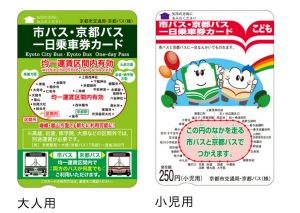

The tourist places along the route.
The tourist places and bus stops
Kyoto Station
The entrance to Kyoto, as you know without needing telling. This trip starts here.
Recently, Hachijo Entrance has been fully maintenanced (Station front Dec 2016 Grand Open), and the South area has been suddenly being widely noticed. Many restaurants and shops are newly opening!
Bus stop : Route 28 “Kyoto Station” is at the bus stop D3 once you get out of the central exit. (As seen in the picture).

Nishi Hongan-ji Temple
“Onishi San”, as you know without needing telling. The head temple of the Joudoshinshuu Hongan-ji group, and also the World heritage. While getting overpowered by the buddhist architecture, why don’t you dig deep into the meaning of “Tariki Hongan (Salvation by faith in Amitabha)” by Shinran Shonin in this solemn atmosphere. Namu Amida Butsu (Hail Amitabha Buddha)
Bus Stop : Short walk from “Nishi Hongan-ji Temple” stop
Avg. Time : 5 mins from Kyoto Station
Address (Japanese) : 〒600-8501 京都市下京区堀川通花屋町下ル
Address (English) : Horikawa-dori Hanaya-cho Kudaru Honganji Monzen-machi, Shimogyo ku, Kyoto 600-8501
Opening and Closing of Gate : 5:30 – 17:30(01/10/2016 〜 31/12/2016)
Tel : 075-371-5181
Website : http://www.hongwanji.or.jp/
Ryukoku Museum

It regularly holds an exhibition of finding the roots of Buddhism as a concept of being a Buddhism museum. You can come across worldwide art and culture not only Japan. This area also has a lot of cafes and shops around the Horikawa street so after you have finished visiting Hongan-ji Temple, you can quench your thirst with coffee while you browse for a Buddhism souvenirs. The good thing is that this cafe allows anyone to come in not only the customers of the museum.
Bus Stop : 2 mins walk from “Nishi Hongan-ji Temple” stop
Avg. Time : 5 mins from Kyoto Station
Address (Japanese) : 〒600-8399 京都市下京区堀川通正面下る(西本願寺前)
Address (English):Horikawa Dori Shoumen Kudaru, Shimogyou Ku, Kyoto (Nishi Honganji Mae) 600-8399
Tel : 075-351-2500
Website : http://museum.ryukoku.ac.jp/index.php
Shijo Omiya
Shijo Omiya, where Shijo Street and Omiya Street intersects. This is where the Keifuku Denki Railway Arashiyama Main Line, a.k.a. Araden’s last stop “Shijo Omiya Station” is located. Arashiyama Main Line goes all the way to Arashiyama, and at “Katabiranotsuji” Station, a station where it’s pretty much impossible to read the Kanji, it connects to Kitano Line where it goes to Kitano Hakubai Cho. Along the line, there’s cherry blossoms, autumn leaves, the famous Buddhist temples and Shinto shrines. If you’re travelling the West side of Kyoto, I prefer you to hop on this train. Shijo Omiya also has Hankyu Omiya Station, so you will not be left without a place to eat. This area is a great place for lunch in Kyoto.
Bus Stop : Short walk from “Shijo Omiya” stop
Avg. Time : 12 mins from Kyoto Station
Website : http://randen.keifuku.co.jp/
Mibudera

This Mibudera is in the Kyoto’s unlucky quarter, and it has been loved by the neighbours as it has been a temple for better luck and warding off evil since the Heian Era. Wolf of Mibu refers to Shinsengumi, who went on a rampage in the last days of the Tokugawa Shogunate. It comes from Shinsengumi making this Mibudera the base of their journey. There are soldiers’ grave enshrined in the precincts now. In Spring, Autumn and Setsubun, a important intangible cultural property act, “Mibu Kyougen” is held. This has been going on since the Kamakura era (1185-1333) and it uses no words or phrases at all.
Bus Stop : 5 min walk from “Mibudera Michi” stop
Avg. Time : 13 mins from Kyoto Station
Address (Japanese): 604-8821 京都市中京区坊城仏光寺北入る
Address (English) : Bukkouji Kita Iru, Boujou, Nakagyou-ku, Kyoto 604-8821
Tel : 075-841-3381
Website : http://www.mibudera.com/
Kasuga Taisha

This shrine is one of the most beneficial shrines in the Ukyo-ward in Kyoto. From healing sickness, safe travelling, and so on. There’s the Hoso Stone which said to have cured imperial princess’ smallpox, and Onae Mound which sacred to the placenta of Ninkoutennou when he was born. I’d like the tourists to pay a visit to the “Modoroki Shrine” inside the Kasuga Shrine for the god of safe trip when you visit this shrine.
Bus Stop : 3 min walk from “Nishi Oji Shijo” stop
Avg. Time : 17mins from Kyoto Station
Address (Japanese):〒615-0015 京都市右京区西院春日町61
Address (English) : 61 Saiiin Kasuga Cho, Ukyou-ku, Kyoto 615-0015
Closing Time : 7 days, gates are always open. Granting Reception 9:00 ~ 17:00
Tel : 075-312-0474
Website : http://www.kasuga.or.jp/
Umenomiya Taisha
It enshrines “Saketoke no Kami” which reads god of alcohol. It is also a shrine for safe delivery for pregnancy. At the back of the shrine, there’s a stone called “Matage Ishi” which comes from when Emperor Saga’s wife gave birth to her son after stepping over that stone. It holds events like “Sweet Sake Festival” for the goodness of the distilling industry, and “Ume Ume Festival” where one of the “ume” means plum, and the second “ume” refers to giving birth. Such a cool shrine which keeps the tradition as well as having something ironic. Inside the shrine, they are selling sake called “jurakudai” by Sasaki Sake Distiller with Umenomiya Taisha original label. Just FYI, Sasaki Sake Distiller is the home of the very famous actor Kuranosuke Sasaki.
Bus Stop : Short walk from “Umenomiya Taisha” stop
Avg. Time : 28mins from Kyoto Station
Address:〒615-0921京都市右京区梅津フケノ川町30
Address (English) : 30 Kaizu Fukenogawa Cho, Ukyou-ku, Kyoto
Tel : 075-861-2730
Website : http://www.umenomiya.or.jp/index2.html
Suzumushi Dera Temple

Listening to the preecher in the auditorium while surrounded by the sound of cricket all year round. It’s time for the famous “Cricket Preach”. Listen to what the priest is saying, and forget about all the hustle and bustle, and just feel the relaxation. Out of all the places in Japan, you can only find the walking jizo here. It is even wearing a Waraji (straw sandal), and it comes to grant you a wish. Thousands of people and jizo believers come here for better fortune. Check out the Jizo and Cricket website as well!
Bus Stop : 20 min walk from “Matsunoo Taisha” stop
Avg. Time : 60 mins from Kyoto Station
Address:〒615-8294 京都府京都市西京区松室地家町31
Address (English) : 31 Matsumurojike Cho, Nishi Gyou-ku, Kyoto
Opening Hours : 9:00 – 17:00(Last Entry 16:30)
TEL: 075-381-3830
Website: http://www.suzutera.or.jp/
Matsunoo Taisha
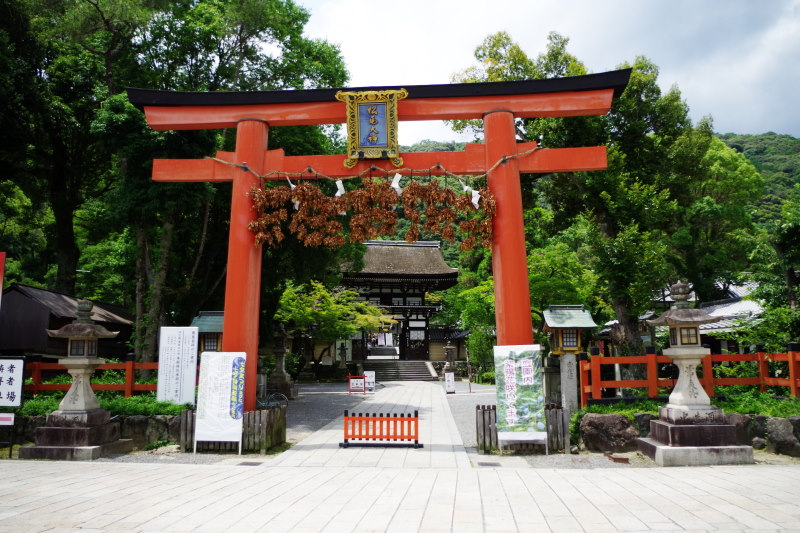
The roots go way back to before primeval time. Hata tribe live around here in the Yayoi ~ Kofun period, and they were excellent in making sake, so Matsunoo Taisha became the most loved GOd of Sake in Japan. The data library of sake is worth seeing. In the shrine, there’s a statue of “Lucky Souri” and “Lucky patting Turtle”. Souri refers to Snapper. Snapper is said to be fish of success and promotion, and Turtle is said to be symbol of immortality. You obviously can’t hop onto either of them, but you can sure pat it.
Bus Stop : Short walk from “Matsunoo Taisha” stop
Avg. Time : 31 mins from Kyoto Station
Address (Japanese):〒616-0024京都府京都市西京区嵐山宮町3
Address (English) : 3 Arashiyama Miya Cho, Nishi Gyou-ku, Kyoto 616-0024
Operating Hours : Weekdays & Saturday 9:00 ~ 16:00 / Sunday & Public Holiday 9:00 ~ 16:30
Tel : 075-871-5016
Website : http://www.matsunoo.or.jp/
Tsukiyomi jinja
It has got a lot of origin, but the roots is in another Tsukiyomi Jinja in the Iki Island in Nagasaki Prefecture, and it also has a connection with the Matsunoo Taisha, mentioned above. The enshrined goddess, “Tsukiyomino Mikoto”, is a god for astronomy, numbers, augury, and voyage, as it used to be the main channel for the traffic from North Korea. However, inside the shrine, there’s a rock called “Tsukinobe Ishi” a.k.a. “Rock for Safe Delivery”, which was the origin for the belief of safe delivery. So it is well known for Safe delivery as well. Recently, it is very popular safe delivery spot for female!
Bus Stop : 300m South from the Red Tori-i Gate of Matsunoo Taisha from the “Matsunoo Taisha” stop
Avg. Time : 31 mins from Kyoto Station
Address (Japanese):〒615-8296 京都府京都市西京区松室山添町15
Address (English) : 15 Matsumuro Yamazpe Cho, Nishi Gyou-ku, Kyoto 615-8296
Tel : 075-394-6263
Website : http://www.matsunoo.or.jp/tukiyomi/index/
Saihou-ji Temple
Well known as “Koke Dera”. It’s a World Heritage. The garden is covered by more than 100 types of moss, which creates a majestic, yet fantastic scene. The leading figure of landscaping, Musou Soseki created this garden. They said Steve Jobs visited this garden, and will capture the attention of anyone. However, it is in the most inconvenient place and it is said to be the hardest world heritage to access. You have to firstly book your visit by a postcard with a reply card attached to it. If you are planning to go on the weekend and public holiday, it’s apparently very hard to book. The admission fee is 3600 Yes including sutra copying.
Bus Stop : 1km from “Matsunoo Taisha” stop (Closest bus stop is “Kokedera Michi” stop on route 29)
Address (Japanese):〒615-8286 京都市西京区松尾神ヶ谷町
Address (English) : Matsuo Jingatani Cho, Nishi Gyou-ku, Kyoto
Tel : 075-391-3631
Website : http://www.kyoto-kankou.or.jp/info_search/?id=9525&r=1331435184.882
Arashiyama Monkey Park

When you say Kyoto, Kyoto University is famous, and when you say Kyoto University, they are famous for the study of the Primates. Arashiyama Monkey Park used to be the place where they researched, which is now open to the public. Recently, it’s been on the eyes of the medias as a deep tourist place. As a result, there are a lot of foreigners… But why so many foreginers and not the locals!? Take some photos while feeding the monkeys with your family or your partner! There’s a spot where you can look down on the city of Kyoto on the top of the mountain.
Bus Stop: 10 min walk from “Hankyu Arashiyama” Stop
Avg. Time:45 mins from Kyoto Station
Address (Japanese):京都府京都市西京区嵐山
Address (English) : Arashiyama, Nishi Gyou-ku, Kyoto
Opening Days : 7 days (Except Storm, and Blizzard)
Opening Hours : 9:00 ~ 17:00(Winter ~ 16:00)
Tel : 075-872-0950
Website : http://monkeypark.jp/
Arashiyama Tsusen

“I feel like rocking on a boat and reading haiku”, It’s an old saying like Shakespeare! What I’m trying to say is that you feel just like a courtier on this boat. You can enjoy the pleasure of the Oigawa River with the houseboat controlled by the boatman with only one pole. Enjoying the seasonal view of Arashiyama from the boat is one way, or to have a luxury lunch by relish in the fantastic food. The Summer tradition “Ukai (cormorant fishing)” is also recommended.
Bus Stop:5 min walk from “Arashiyama Kouen” stop
Avg. Time:36mins from Kyoto Station
Address (Japanese):嵐山通船株式会社「北乗り場」 〒616-8385 京都市右京区嵯峨天龍寺芒ノ馬場町
「南乗り場」 〒616-0004 京都市西京区嵐山中尾下町
Address (English) : Arashiyama Tsusen Kabushiki Kaisha “Kita Noriba” Saga Tenryuji Susukino Baba Cho, Ukyu-ku, Kyoto / “Minami Noriba” Arashiyama Nakao Shita Cho, Nishi Gyou-ku, Kyoto
Opening Hours : 9:00~16:00
Operating Hours : 7 days (Except New Years Eve and New Years Day) Boat will be cancelled in extreme weather. / Plans other than “Entertainment cruise” and “Ukai Seeing cruise” should be booked in advanced.
Tel : 075-861-0302
Website : http://arashiyama-yakatabune.com/
Togetsukyou
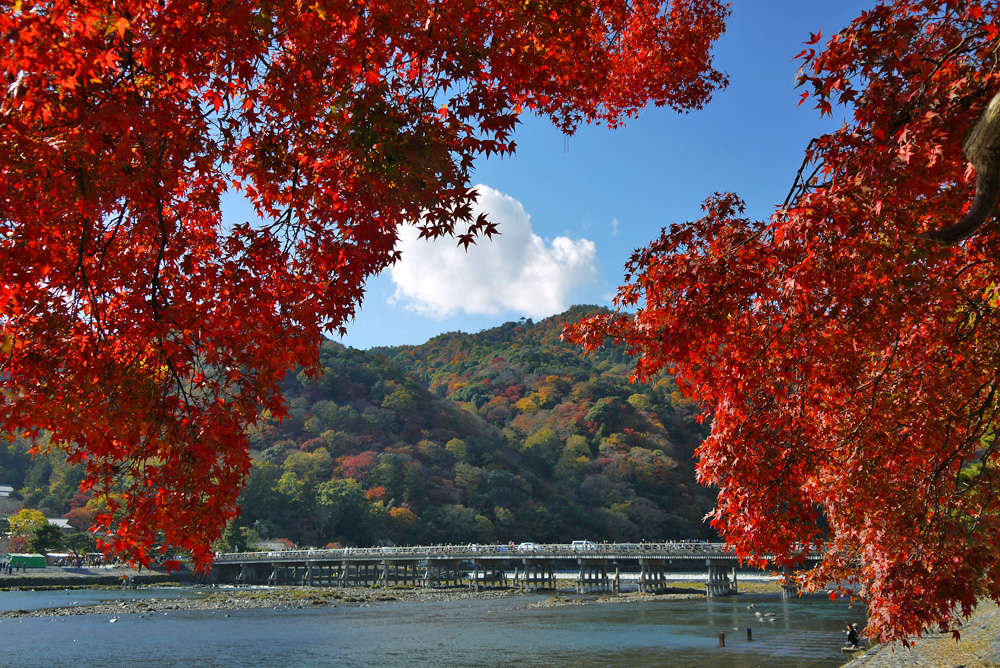
No need for an explanation for one of Kyoto’s, in fact, Japan’s most beautiful scenery. As Shiba Ryotaro once said “The horizontal line of Togetsukyou divides the scene into the golden ratio”, the bridge itself is not that dignified, which blends into the nature well. Also on a TV show on NHK “Buratamori”, they were introducing by saying the mountain on the other side of Togetsukyou is really steep which allows the trees to show its own colour clearly to give that spectacular view. Even the people that haven’t been there or people that have been there, let’s just take one step away from the bridge and enjoy the beautiful composition of Togetsukyou. By the way, the river that flows underneath Togetsukyou is called “Oigawa”, and the upstream from Togetsukyou is called “Hotsugawa”, and the downstream from Togetsukyou is called “Katsuragawa”
Bus Stop:2 min walk from “Arashiyama” stop
Avg. Time:36 mins from Kyoto Station
Tenryu-ji Temple
Built by Ashikaga Takauji in 1339. The garden was made by the talented artist Musou Soseki who was on another level in that period. The expense of Tenryu-ji Temple with such gorgeous garden including Arashiyama and Kameyama, was not enough that they had to re-start the trade with China, and back then, that meant Japan lost their prestige. Tenru-ji boat was what played a main role at the time. Sougenchi Teien is a must see. Tenryu-ji Temple is now contributing to the country as a world heritage, since it ruined the government back then. On the roof of Hattou, there’s a 10 metre by 12 metre painting of Unryu-zu (painting of dragon and clouds) which is staring us from all sides. It’s pretty scary how the painting is staring us wherever we stand.
Bus Stop:Short walk from “Arashiyama Tenryu-ji Mae”
Avg. Time:54 mins from Kyoto Station
Address (Japanese):〒616-8385 京都府京都市右所要時間区嵯峨天龍寺芒ノ馬場町68
Address (English) : 68 Saga Tenryu-ji Susukino Baba Cho, Ukyou-ku, Kyoto 616-8385
Opening Hour : 8:30 – 17:30
Unryu-zu : Only open on the weekend and public holidays. Open every day on the special worshippnig days in Spring, Summer, and Autumn.
Arashiyama Hanatoro (Light and Blossom Pathway) period : Opening Hour 9:00 ~ 17:00 (Closed at 16:00 between 21/10 ~ 20/03)
Tel : 075-881-1235
Website : http://www.tenryuji.com/index.html
Nono Miya Jinja Shrine
The very famous place for been used in the Tales of Genji, was a place where the children from the aristocracy make themselves purified before representing the emperor when serving at Ise Jingu. It is very popular for being the god of study, love, and children. It is very easy to access as it is on the pathway of a bamboo forest. When you think of Tales of Genji, this place sounds really appropriate for a romantic love.
Bus Stop:5 min walk from “Nonomiya” stop
Avg. Time:58 mins from Kyoto Station
Address (Japanese):〒616-8393京都市右京区嵯峨野宮町1
Address (English) : 1 Saga Nonomiya Cho, Ukyou-ku, Kyoto 616-8393
Website : http://www.nonomiya.com/
Chikurin No Komichi
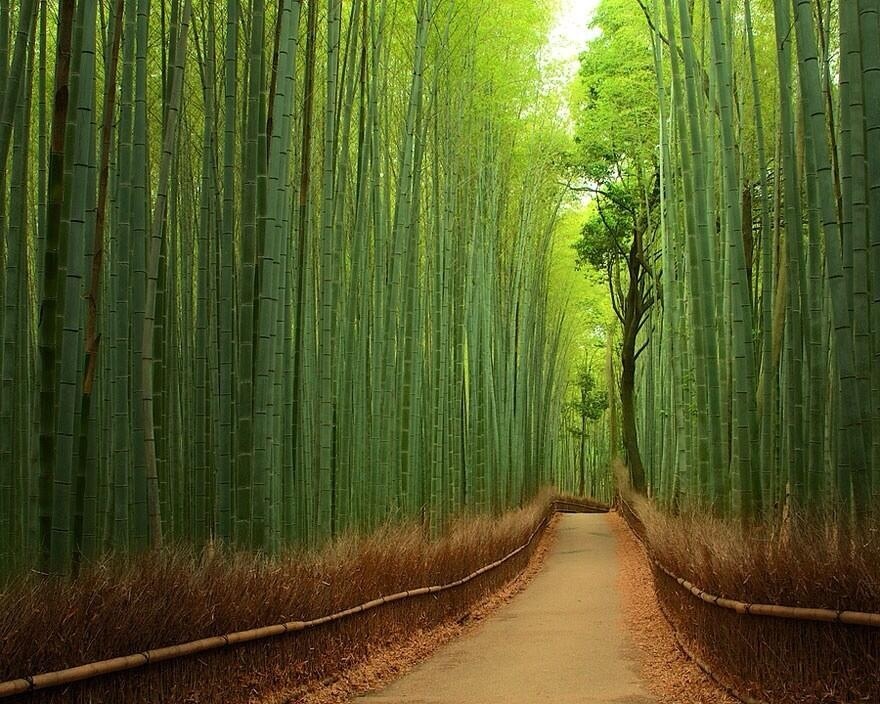
It’s a pathway about 300m from Nono Miya Jinja Shrine to the Okouchi Sansou. The fresh bamboo grows as if it’s covering the whole pathway, and no one will realise that the one’s self is slowly blending with the nature as the silence looms from both ends. You’ll start respecting and loving the nature as you walk along this pathway, and you’ll soon feel that the Japan’s Yaoyorozu belief (where people thinks there is god in everything they see) was created from animism.
Bus Stop: 5 min walk from “Nono Miya” stop
Avg. Time:58 mins from Kyoto Station
Address (Japanese):〒616-8393京都府京都市右京区嵯峨小倉山田渕山町
Address (English) : Saga Ogura Yamada Buchiyama Cho, Ukyou-ku, Kyoto 616-8393
Jojakkou-ji Temple
A Buddhist temple of Nichirenshu, located at halfway up Ogura Mountain. At the back of the precinct, there’s the remains of the Shiguretei where Fujiwarano Sadaie have said to edit the Ogura Hyakuninn Isshu (Anthology of One Hundred Tanka by One Hundred Poets). Jojakkou-ji is also very popular place for Autumn Leaf. The hill from the gate to the main temple is covered by red Japanese Maple. Once you reach the Tahoutou, an important cultural property, you can look down on the red coloured city of Kyoto.
Bus Stop:10 min walk from “Saga Shougakkou Mae” stop
Avg. Time:66 mins from Kyoto Station
Address (Japanese):〒616-8397京都市右京区嵯峨小倉山小倉町3
Address (English) : 3 Saga Ogurayama Ogura Cho, Ukyou-ku, Kyoto 616-8397
Opening Hour : 9:00〜17:00 (Reception closes at 16:30)
Tel : 075-861-0435
Website : http://www.jojakko-ji.or.jp/
Daikaku-ji Temple
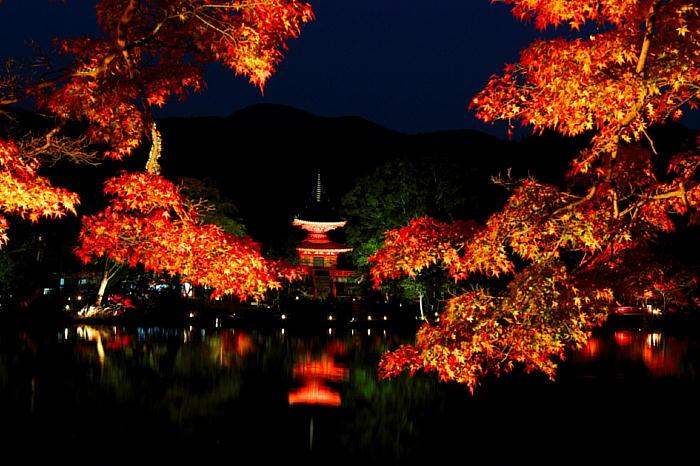
The last place on Kyoto City Bus route 28 is Daikaku-ji Temple (remains of the former Saga Imperial Palace). It used to be an imperial villa of Saga emperor, then became the head temple of the Shingon sect Daikaku-ji ha, founded by Kobo daisha Kukai. When the famine hit the city, Kobo daisha prayed to the five great wisdom kings such as the Fudou Myouou (Acala), and brought back peace to the city. You can experience discipline training at Daikaku-ji Temple now. There’s a Sutra copying, or transcribing the choice of your buddah as well. On the website, there’s a difficulty on each sutra copying, so please use it as a reference. your face will sure look like one of the wisdom king whilst you concentrate on dispersing the bad. I’d like to wish you a safe trip on the bus and finish off the article here.
Bus Stop:Short walk from “Daikaku-ji” stop
Avg. Time:61 mins from Kyoto Station
Address(Japanese):〒616-8411 京都府京都市右京区嵯峨大沢町4
Address (English) : 4 Saga Osawa Cho, Ukyou-ku, Kyoto 616-8411
Opening Hour : 9:00 – 17:00 (Reception cloases at 16:30)
Tel : 075-871-0071
Website : https://www.daikakuji.or.jp/
Daikaku-ji Temple Cafe
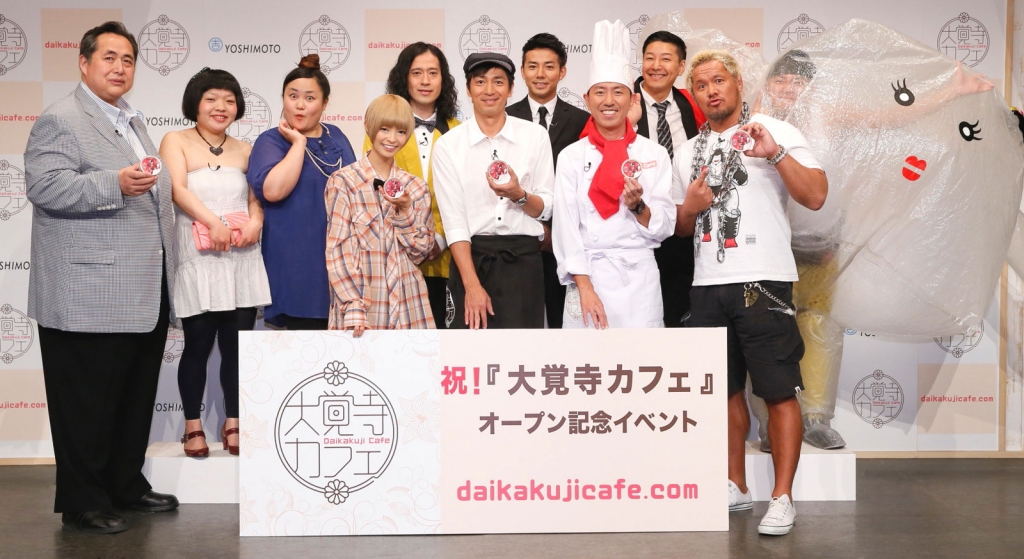
You can book out the temple for events like cosplay, press conferece, concerts, and photoshoots. It’s some what unique temple!
Cafe in Daikaku-ji Temple, operated by Yoshimi Tokui from Sakyou-ku, Kyoto. He has booted up a flower arrangement club “Ikebana Skirt”, and a Sutra Copying club “Tetsuo Juku”, with his buddy / head chef Mitsunori Fukuda. In Tetsuo Juku, a comedy group Waraimeshi’s Tetsuo is the principal, and in Ikebana Skirt, Japanese Idol Group “Mirai Skirt” studies, and introducing flower arrangement.
Tetsuo Juku Website : http://daikakujicafe.com/tetsuojuku
Ikebana Skirt Website : http://daikakujicafe.com/ikebana




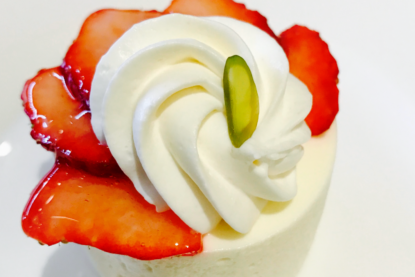
No Comment